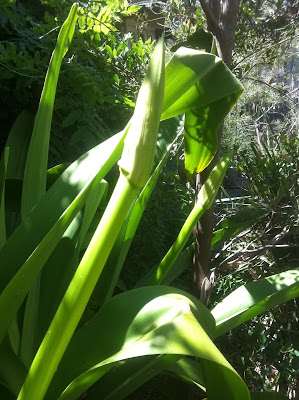Great
news for conservationists (and conversationalists)! Two “lost” species are returning to our
suburbs. The Long-nosed Bandicoot, a once common resident (but not seen in
Manly Vale for 45 years) is amazingly, making a comeback. And the
Brush-turkey..a rare visitor to Sydney in the last 20 years or so, is now
strutting up and down my street (and many others) with “gay abandon”.
Bandicoots,
it seems, have benefited from targeted fox baiting and their numbers are
bouncing back, as the population of this introduced predator is curtailed. Brush (or Scrub) Turkeys, which were virtually
wiped out by hunting and loss of habitat (apparently their tough and stringy
meat provided many a family feed during the Great Depression) are also
reclaiming their territory.
Of
course these great examples of wildlife resilience has stimulated a cacophony of
criticism. Some churlish people baulk at the small v shaped holes that
bandicoots make in lawns when looking for grubs...whilst the fact that
Brush-turkeys build large nesting mounds doesn’t win them many fans (especially
with the “English style” manicured garden brigade). The irony is , these “protected species”,
vilified by some for their habitual digging, are benefiting us all by doing
just that !
A
recent Murdoch University study has found that native digging animals (also including Bilbies,Potaroos etc) play a key role in promoting eco-system health. Their activities increase soil nutrition,
seed dispersal and water infiltration. Some foraging animals are also credited with
reducing bush-fire risks by taking leaf litter underground. The diggings of
feral species such as rabbits, in contrast, promote the spread of weeds and have a
negative effect on the soil.
Imagine
how our landscape might have looked if we hadn’t systematically eradicated most
of our native wildlife! (Australia has the world’s worst record for mammal
extinction in the last 200 years). So please, embrace these lovely “diggers” give them some space, keep your pets away and
make the wildlife feel at home!
Long -nosed Bandicoot (Perameles
nasuta)
A nocturnal
marsupial with large pointed ears and a long muzzle. It is greyish brown in colour with a creamy
white forefeet and under-body.
Habitat:
Rainforests, woodlands, heathland, grasslands.
Distribution:
from Vic to Qld borders.
Size:
310-425mm
Lifespan:
around 2.5 years
Diet:
Omniverous. Primarily beetles, ants, larvae, fungi, roots, shoots.
Breeds:
July to March
Gestation:
only 12.5 days (shortest of any mammal)
Litter:
1 to 5. In a good year, females may
produce up to 4 litters.
Predators:
dogs, cats, foxes (and cars)
An “isolated” population of around 200 can be
found at Manly’s North Head and is listed as “endangered”.
 |
| Sadly, many Bandicoots fall prey to domestic cats (photo James Taylor) |
Australia Brush-turkey (Alectura
lathami)
One
of three Australian “Mound Builders”- the other two being the mallee fowl and
the orange-footed scrubfowl. It has deep black plumage, bare red head and neck,
a broad flat fan tail. Males have a redder head and neck and a distinguishing
yellow “wattle”. A chick looks similar to a quail and has brown feathers.
Habitat: Rainforest and eucalypt forest
Distribution: Australia’s east coast from NSW to Queensland
Size:
60-70cm body length.
Lifespan:
10 years
Diet:
Leaf litter, invertebrates and fruits
Breeding: Occurs from August to January. The male
brush-turkey builds a large mound of organic matter up to 6 metres wide and 1.5
metres high. The females are attracted to a well built and maintained mound and
one or more birds will lay eggs inside it. The decomposition of the vegetation
inside the mound produces heat The male checks the temperature by inserting his
bill and then adds or removes material to maintain a 32to 33 C degree
temperature. After around 50 days the young brush-turkeys hatch and have to
fend for themselves.
Female
brush-turkeys lay between 20 and 30 eggs a year. (one mound may contain up to
150 eggs over a season)
Predators:
Goannas, snakes, birds of prey, foxes, domestic cats and dogs. To protect
themselves, brush-turkeys form roosting groups in trees.






























